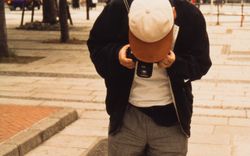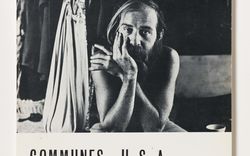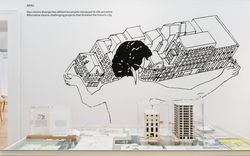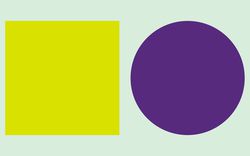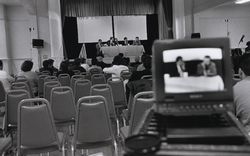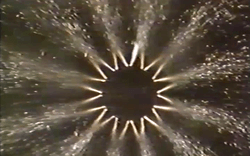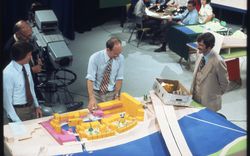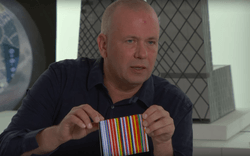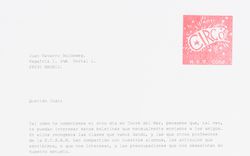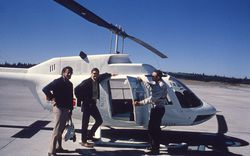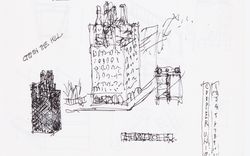Looking for a New World
By Pierluigi Nicolin
In the book Kommunen in der Neuen Welt 1740–1972,1 the search for an alternative to an individualistic society, oriented toward profit and competition, was conducted through an exploration of the settings and places where the spiritual quest for utopia had already been made, reliving its innumerable adventures. Liselotte and Oswald Mathias Ungers’s 1972 account of their pilgrimage to the legendary settlements of the nineteenth-century American utopia is open to a comparison between the communes of yesterday and today with the conviction that alternatives have always found new moments of flowering, and that a temporary ebb of the movement does not imply the abandonment of the dream of a nonviolent social and cultural revolution.
Although the beginning of the 1970s was a period of radical avant-gardes, flourishing hippie communes, and other manifestations of the counterculture, the most surprising thing for anyone who came across the book was the revelation of the identity of its authors—as unexpected as its subject—even to the narrow circle of experts and friends who knew that Oswald Mathias had moved with his wife Liselotte to the United States in 1968 as a reaction to the excesses that had occurred that year in Berlin. In fact he went to teach at Cornell University, where he had been named Chair of the Department of Architecture. He was devoting himself to competition projects and theoretical research into morphology and the processes of urban change: privileging a conception of the architecture studio antithetical to that of the big professional office and closer to that of an ideal artistic family. Evidently there was more to it than that, given that in this context the tight-knit couple—Oswald Mathias said of Liselotte, quoting Seneca, “I write this not for the many, but for you; each of us is enough of an audience for the other”2—decided to make numerous trips around the United States in search of places that were symbolic of the pacifist utopia, setting out on a sort of pilgrimage as if they wished to make up for their disappointment with the violence that had occurred during the 1968 protests in Berlin, against the university institution (the Technische Hochschule) where Ungers was a professor.
The leitmotif of pacifism, along with a particular attention to the fate of the communities founded by groups of German origin and emerging out of European religious movements—like the Amana Colonies of the Inspirationalists, an offshoot of the German Pietist movement of the sixteenth and seventeenth centuries, or the Hutterites, who can be traced back to the sixteenth-century Anabaptists—distinguishes the approach taken by the Ungers from other treatments of the communes of the New World, which focus on the quest for a new Eden or New Jerusalem, or that are focused on secular ideas of utopian socialism.
There can be no doubt that the investigation of these collective enclaves—engaged in the laborious development of models of what they believed to be the perfect city—and the study of the interaction between ideology and architecture and between social planning and physical planning in the American utopian communities stimulated the development of O. M. Ungers’s architectural and urbanistic ideas. In different ways the various utopias realized well-defined scenarios that inspired at the same time a classificatory approach and the exercise of a genuine ars combinatoria. In essence this was an obsession of the Fourierist utopia, too. In the settlements created by American communities, the built substance of the utopian enclave—the urban architecture in its various aspects—was realized in discrete elements. It seems that each block of houses or buildings was a variant of a single block and that they could be arranged in an indefinite number of narrative functions. For an architect inclined to play a structuralist game with morphologies, the experience of the ars combinatoria was made possible on the basis of a list of the various urbanistic models of the settlements and of the architecture of which their building material was made: a material already arranged in discrete elements that were needed, as we know, by utopia in order for it to be able to represent itself in a transparent way.
In any case, the structure of the book reflects Oswald Mathias’s systematic spirit whereas the influence of Liselotte’s personality can be traced above all in the narrative dimension and the tone of the writing. Here the figure of someone seeking something gains the upper hand, with a sincere display of sympathy for the dilemmas common to all utopian societies: the conflicts between authoritarian and participatory processes, between the common and private spheres, and between the idea of a self-contained community and one that is replicable and open to the world. The themes of pacifism, the emancipation of women, marital relationships, and the education of children explored in the text have a literary precedent in August Strindberg’s short story Nybyggnad (“New Building”) in which an emancipated young woman searching for an alternative to an individualistic society oriented toward profit and competition tries in vain to fit in to the society of her time and ends up seeking refuge in a utopian community called the Familistère.3
-
Liselotte and Oswald Mathias Ungers, Kommunen in der Neuen Welt 1740–1972 (Cologne: Kiepenheuer & Witsch, 1972). ↩
-
Oswald Mathias Ungers, “When one deals with architecture,” Lotus International 57 (1988): 36. ↩
-
August Strindberg, Utopier i verkligheten. Fyra berättelser (Stockholm : A. Bonnier, 1885). ↩
